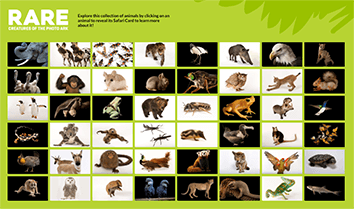Including: Safari Slideshow & Creature Cards
Explore NowJoel’s Photography Tips
World-renowned photographer Joel Sartore is on a mission to photograph the world’s most rare and vulnerable species. If you want to start your own photo ark, or simply take your everyday photographs to the next level, check out Joel’s top photo taking tips:

1. You can take a good picture with just about any camera these days.
Just look at the millions of Instagram photos uploaded daily, most shot from smart phones. What’s most important is learning to see well. Pay attention to the subject, the light on it, the background, and the space around the subject. A lot of problems can be solved very quickly just by looking at everything in the frame. Great photographers are visual problem solvers.
2. Good photography of anything has three common elements: nice light, a clean background, and interesting subject matter.
The first three are pretty self-explanatory. My test for whether or not something is interesting to photograph is, if I were driving along with my wife and saw something on the side of the road, would she be glad I interrupted whatever she was doing to point it out, or would she just be annoyed?
3. Use perspective to keep unwanted elements out of the frame.
Take your photo from a different angle. Try getting down on the ground and take the picture from that angle—the worm’s eye view. Or get up high and shoot from the bird’s eye view. You can move your subject around, but you can move around too. And make sure nothing’s sticking out of someone’s head!
4. If you want to take good nature photos, be out in the field and ready to shoot before sunrise, and be willing to work in the evenings until after sunset.
That’s when the light is nicest and it’s also when many animals are most active.
5. To take full advantage of the good light at the beginning and end of the day, you’ll need a tripod and a cable release.
The light is usually nicest when it’s lowest, so if you’re shooting hand-held, camera-shake can wreck your pictures and leave them a blurry mess. A tripod and cable release eliminate camera shake, and are an easy way to improve your pictures.
6. When working with nature, it is absolutely crucial to respect your subject and surroundings.
This means the usual outdoors etiquette (leave everything as you found it and take your trash out with you), and with wildlife it means disturbing your subject as little as possible. Learn what the rules of conduct are, what a respectful distance is, what behavior to avoid, and what the “back-off” signal is. The goal is to safely get good photos of your subject behaving normally, not showing aggression or running away from you.
7. Before you even set foot in the field, research your subject(s) thoroughly and talk to people who know the area you’ll be working in.
Do your homework and don’t waste the time of the people who are helping you out.
8. Always send people (whether they’re your subjects or the people who have helped you out) the prints you’ve promised them.
Following through shows that you really appreciate the help they’ve given you, and chances are they’ll be willing to help you out again if the need arises.
9. Be prepared for the environment you’ll be working in.
Photography often involves extreme conditions, and it’s tough to work when you’re cold and/or soaking wet. And working in cities means you’ll need sturdy footwear with arch support so that you’ll not beat yourself up. So, make sure you’ve got the proper clothing and equipment.
10. Always carry backup equipment.
For professionals, this means extra cameras and lenses — which gets expensive, fast. However, it’s relatively inexpensive to carry an extra set of batteries and an extra memory card. You’ll be surprised at how often they can save the day. There’s nothing more frustrating than missing a great shot because your gear isn’t working.
11. Persistence is key.
Many of the best shots come at the end of the day when you’re worn out and ready to pack it in. If you leave early, you’ll miss out on some of the best opportunities.
12. The more you shoot and the more time you spend studying other people’s photos, the more your photography will improve.
Get familiar with your camera and other equipment in a setting where you’re comfortable (your own back yard is a great place to start). That way when you’re looking at an eagle soaring over a breathtaking landscape, you won’t miss the shot because you were fumbling with your camera. If you’ve practiced, you’ll know exactly what to do, and stand a much better chance of getting the shot.
Have a question for Joel? Drop him a note on Facebook or Twitter.

I want people to care,
to fall in love,
and to take action.
Joel Sartore
National Geographic Photographer
How you can help
Snap a pic
Take a photo of a creature in your neck of the woods. Show your support by posting your animal pic using the hashtag #RarePBS.
Be pollinator-friendly
Plant local plants in your garden to help bees, birds, and other pollinators. Encourage others in your neighborhood to do the same.
Reduce, reuse, recycle
Reduce what you buy, reuse and repurpose what you do buy, and recycle what can't be repurposed.
Learn More


